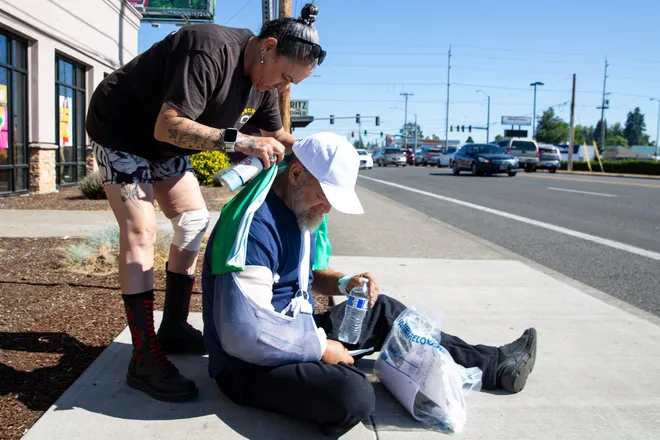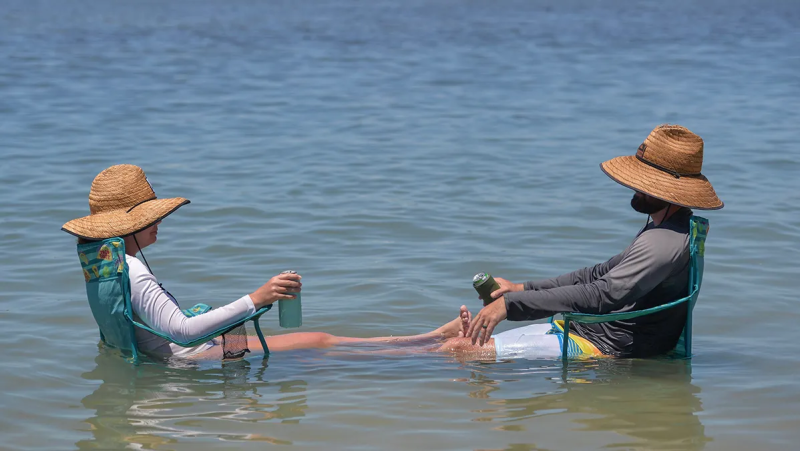Keep your cool: Experts on how to stay safe, avoid sunburns in record-high temps
A traveler in California's Death Valley who suffered third-degree burns on his feet after his flip-flops were lost or broken, forcing him to walk across the scorching sand barefoot. Three children and one adult hospitalized for heat exhaustion after they got lost during a family reunion hike in Arizona amid triple-digit temperatures. More than 50,000 skin cancer cases in 2019 deemed "preventable" by doctors.
As summers grow hotter every year and this summer's heat waves linger, doctors and medical experts warn Americans to keep an eye out for the dangers to the human body of extreme heat and scorching sunrays that can trigger heat exhaustion and heatstroke, cause severe sunburns, and lead to skin cancer down the line.
"When it comes to extreme heat, there are profound impacts on the skin and on overall health," said Seemal Desai, president of the American Academy of Dermatology.
Just last month, at least 30 people across the West lost their lives to the heat wave. Last year, heat claimed more than 2,300 lives in the U.S., an increase of a third from the year before, according to the Centers for Disease Control and Prevention. The CDC also logged nearly 120,000 emergency room visits for heat-related conditions in 2023, more than 90% of which came during the summer months.
Experts say the official death toll from extreme heat is likely a significant undercount – heat often doesn't appear on death certificates, even if it was a factor. And as climate change drives temperatures to more extreme heights, heat-related deaths will increase, said Kristie Ebi, a professor at the University of Washington's Center for Health and the Global Environment.
"It's called a silent killer, because we just don't know the exact numbers," Ebi said. "But the more estimates are made, the more that's understood about this undercount, the more incentive there is for investments to ensure that this issue is addressed."

How extreme heat pushes the body out of its comfort zone
Some groups are much more vulnerable to extreme heat, including children, outdoor workers, pregnant women, and people over 65, according to Ebi.
Chronic diseases, especially cardiovascular conditions, also put people in greater danger. "When you look, after a heat wave, at the number of excess deaths, about half of those are due to cardiovascular causes," she said. People with an underlying heart condition are "more susceptible to having a heart attack or something else" triggered by the heat, she said.
The human body runs into trouble when its core temperature rises above its narrow natural range, Ebi said.
"We have a range of mechanisms – behavioral mechanisms, physiological mechanisms – to keep our core body temperature where it needs to be," Ebi said. "When those are not sufficient to the level of heat strain, then your core body temperature starts to rise, and that affects your cells and your organs."
One of the dangers of extreme heat is that people often don't notice the warning signs until they're at severe levels, Ebi said. Some people also mistakenly write off the risks because they're young, in good physical shape, or have experienced extreme heat before, she added. "You hear people say, 'Well, I was in heat waves before and I was fine,'" she said.
But "heat waves now are much hotter than they used to be," she said. Also, "depending on how long ago you were in a heat wave, you're that much older, and so your health may have changed."
More:Protect your car from heat damage: Take these precautions in extreme temperatures
Stay hydrated, watch for warning signs of heatstroke
One easy way to cut the health risk of heat could be to stay out of it. Desai advises his patients to avoid going outside during a sizzling hot day between the peak sunlight hours of 10 a.m. and 2 p.m. If they must be out, people should seek shade whenever possible, he said.
People should also keep a close eye on their hydration and drink plenty of water, not just caffeinated beverages or sports drinks, which are hydrating but have other chemicals and additives, Desai said.
Kelly Olino, assistant professor of surgical oncology at the Yale School of Medicine, advises people to dilute a bottle of Gatorade with water to replenish both water and replace salt losses. "In the extreme heat, with sweating, we're losing pure water, but we're also losing salt," she said.
Olino urged people to keep watch for the serious warning signs of heatstroke or heat-related illness – nausea, vomiting, or lightheadedness. "Those things can actually cascade pretty quickly to a dangerous situation."
Sunrays cause short and long-term skin damage
Many Americans are aware of the need to protect their skin from harsh sunrays. The facts are blistering – the UV radiation not only burns skin in the short term, but can also cause damage on a DNA cellular level and even affect the body's ability to regulate temperature, Desai said.
"The higher the UV index, the shorter period of time before you can expect to be burnt," Olino said.
When UV exposure racks up, the body can no longer remove disease cells, and cancer can develop. At Olino's surgical practice, "from April until October, we are inundated with new people with new diagnoses of skin cancers."
Desai sees the more immediate impacts on a day-to-day basis in his practice. "I saw at least 11 to 12 sunburns this week alone," he said. Some patients wear sunscreen but forget to reapply, he said. Others forget that even short term exposure can cause a burn.
Desai said the last few hot months brought a noticeable rise in patients reporting sunburns. "In my practice alone, I am seeing a significant uptick in sunburns this summer, which isn't surprising," he said.
Experts advise wearing a broad spectrum sunscreen of SPF 30 and making sure to reapply it regularly. Olino said people should always scan the label of sunscreen for the keyword "dual broad spectrum," meaning it will block both UVA and UVB rays.
More:Protect yourself from extreme heat: How to stay cool in a heat wave
Common myths about sunburns and tans
Among the common misconceptions Desai hears surrounding sunburns is that a low value on the UV index shown by many weather forecasts, like the Weather Channel and the Apple weather app, means people don't need to take precautions. "Even on a cloudy day, up to 80% of the sun's UV rays can pass through the clouds," he said.
Sun damage can affect patients of any skin color, ethnic background, skin type and skin tone, Desai said.
"A lot of people say, 'Oh, I'm darker skin tone, so I'm not going to get a sunburn,'" he said. "That's not true."
Since sun damage isn't always visible, especially on darker skin, "prevention is key," Olino said.
Desai said one myth out there is that, if there's no sunburn, there was no damage to the skin. "That's not always true," he said. Overall, any changes in skin, like suspicious or changing skin lesions, should prompt a visit to a board-certified dermatologist, he said.
One myth Olino has hears is that building up a "base tan" early on in the summer can protect skin from the sun.
"That's a real myth," she said. "At best, your body can produce enough pigment to give you maybe the equivalent of an SPF 4," as compared with the recommended protection level of SPF 30.
How to stay safe
People can also protect themselves by the clothing they choose. Those spending time outdoors should look for sun-protective clothing with a UPF, or ultraviolet protection factor, rating of at least 50, Olino added.
And if you do get a sunburn, Olino encouraged people to treat sunburns like any other inflammation.
"When you sprain your ankle, it swells, it's red, it's inflamed, and people very much look at that and say, 'Oh, I've got to rest it," Olino said. "For some reason, people don't actually take that same everyday logic and apply it to when they have a sunburn."
While sun damage is prevalent, those that are out and about should also steer clear of hot surfaces.

The danger of burns from making contact with a hot surface, like those suffered by the Death Valley visitor earlier this month, is environment dependent, Desai said. Still, walking without shoes on a hot sidewalk can damage the outer layer of skin, he added.
Raising public awareness of the risks of extreme heat and encouraging people to check on their loved ones can go a long way, said Ebi of University of Washington.
"People will look after family, friends and colleagues and make sure that we all protect each other, that we're all taking the actions that we need during periods of high temperature so we can avoid all these preventable hospitalizations and deaths," Ebi said. "The more people are aware of this, then the better off we'll all be."
Cybele Mayes-Osterman is a breaking news reporter for USA Today. Reach her on email at cmayesosterman@usatoday.com. Follow her on X @CybeleMO.
Disclaimer: The copyright of this article belongs to the original author. Reposting this article is solely for the purpose of information dissemination and does not constitute any investment advice. If there is any infringement, please contact us immediately. We will make corrections or deletions as necessary. Thank you.





